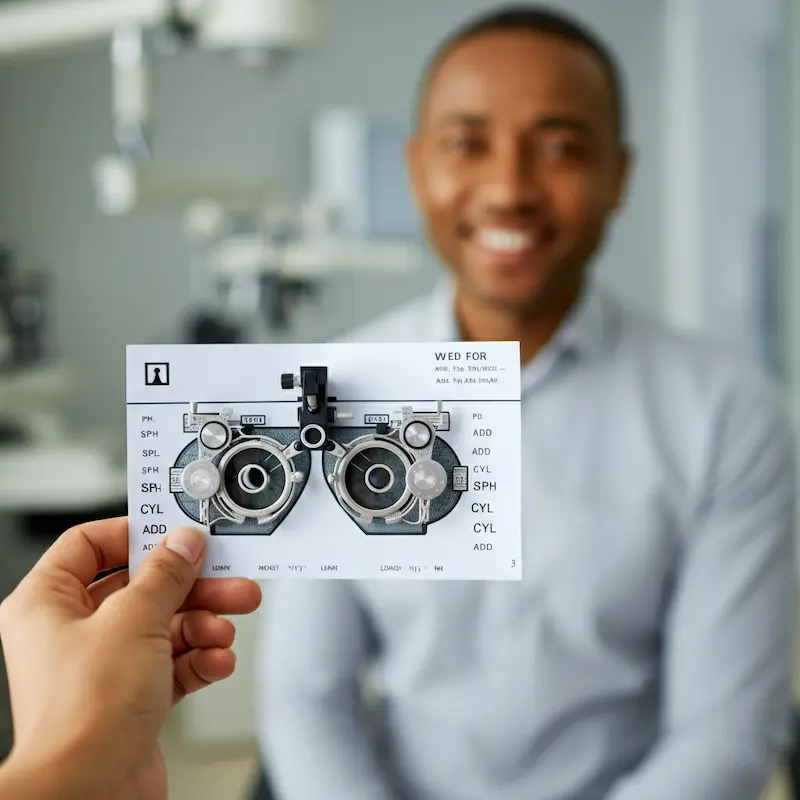Understanding Your Eyeglass Prescription: A Simple Guide
Your eyeglass prescription isn’t just a random series of numbers—it’s a personalized key to better vision and comfort. For adults 55+ living in The Villages, Florida, understanding your eyeglass prescription explained is not only empowering but also important to making informed choices about your eye health and lens options. This simple guide will break down the technical terms and numbers on your prescription, help you grasp what they mean, and show you how they affect your lenses.
Whether you’re nearsighted, farsighted, or need additional help with reading, your prescription holds the answers. By decoding terms like SPH, CYL, and ADD, and understanding how they influence your lenses, you’ll be equipped to get the best vision correction for your lifestyle. Bring your prescription along to explore lens options in a personalized consultation at our office.
What Is an Eyeglass Prescription?
Your eyeglass prescription is essentially a detailed snapshot of your vision needs. Given after a comprehensive eye exam, it includes specific measurements that guide the creation of lenses tailored to correct your eyesight. If you’ve looked at your prescription and felt overwhelmed by the symbols and numbers, you’re not alone! Terms like SPH, CYL, and ADD often confuse patients, but they simply describe the corrections needed to address your unique vision issues.
Decoding Key Terms on Your Prescription
SPH (Sphere): Correcting Nearsightedness or Farsightedness
- The SPH value on your prescription shows whether you’re nearsighted (myopia) or farsighted (hyperopia).
- If your SPH number has a minus sign (-), you’re nearsighted, meaning you have difficulty seeing objects at a distance.
- If the number has a plus sign (+), you’re farsighted, meaning you struggle to see objects up close.
CYL (Cylinder): Addressing Astigmatism
- The CYL value measures astigmatism, a common condition where the cornea is irregularly shaped, causing blurred or distorted vision.
- If CYL is listed, your lenses will include specific adjustments to correct the uneven curvature of your eye.
You might also see an “Axis” value alongside CYL. This simply refers to the direction of the correction needed, measured in degrees.
ADD (Addition): Help for Close-Up Vision
- ADD is relevant for individuals needing bifocals or progressive lenses, especially common among adults over 40.
- It describes the extra lens power required to aid your near vision, making activities like reading much easier.
For instance, an ADD value of +1.75 means your lenses include an additional +1.75 strength for close work, helping you avoid eye strain and fatigue.
Other Notable Values
- PD (Pupillary Distance): Refers to the distance between the centers of your pupils. It ensures your lenses are properly aligned with your eyes.
- Lens Type Notes: Your prescription may suggest single-vision, progressive, or bifocal lenses, depending on your vision needs.
These measurements, taken together, create lenses that provide seamless clarity and comfort in your daily life.
How These Numbers Influence Your Options
Your eyeglass prescription isn’t just about correcting your vision—it also determines the style and functionality of the lenses you choose. Here’s how the values translate into lens options.
SPH and Lens Thickness
Stronger prescriptions (higher SPH numbers) may require lenses designed to minimize thickness. High-index lenses, for instance, are thinner, lighter, and ideal for enhancing comfort without sacrificing style.
CYL and Vision Precision
Astigmatism correction ensures you get sharp, clear images. Incorporating the right CYL and axis values ensures your lenses adapt perfectly to your eye shape, reducing glare and distortion.
ADD and Multifocal Designs
If you need help with near vision, progressive lenses or bifocal designs include your ADD correction. These lenses eliminate the need for switching between different pairs of glasses for reading and distance vision.
To explore lens types and how they can be shaped to your prescription, you can visit our dedicated contact lenses page for more options.
Caring for Your Vision in Our Screen-Driven World
If you spend long hours in front of digital screens, safeguarding your eyes is more important than ever. Blue light filtering lenses help reduce glare, diminish fatigue, and make screen time more comfortable. These optical measures may play a key role in preserving eye health over time. For a trusted overview of how blue-light lenses function, see All About Vision’s guide on their effectiveness.
But clear vision depends on more than just lenses. Balanced nutrition, routine eye exams, and smart screen habits all help maintain healthy sight. Incorporating foods rich in lutein, zeaxanthin, vitamins C and E, and omega-3s supports eye health, as explained in the American Academy of Ophthalmology’s diet & nutrition guide.
Why Personalized Consultations Matter
Reading your prescription is the first step in understanding your vision needs, but the real magic happens when you work with a professional to bring it to life. Our local expertise can help you explore lens options suited to your style, lifestyle, and budget. For custom recommendations tailored to your prescription, visit our website or stop by in person.
When you bring your prescription, we’ll help you choose from options such as:
- Polarized lenses for outdoor clarity and UV protection
- Progressive lenses for all-in-one near-to-distance accuracy
- Lightweight, durable materials for all-day comfort
Seeing is believing—come experience the difference at our offices in The Villages!
FAQs About Your Eyeglass Prescription Explained
1. Can my prescription change over time?
Yes, your prescription can change as your eyes age or if you develop new conditions. Regular check-ups ensure your lenses stay up-to-date.
2. How often should I update my glasses?
It’s generally recommended to have an eye exam every 1–2 years, particularly for adults 55+.
3. Can I use my eyeglass prescription for contact lenses?
No, contact lens prescriptions include details not found on eyeglass prescriptions, such as lens material and fit. Check out more about contact lenses here.
4. What if I lose or misplace my prescription?
We can help! Our team keeps records of your prescriptions so you can access them whenever needed.
Take the Next Step to Clear Vision
Understanding your eyeglass prescription demystifies the world of lenses and empowers you to take control of your vision care. When you bring your prescription to our office, we’ll guide you through options designed to fit your unique lifestyle, whether you’re golfing, reading, or enjoying the Florida sunshine.
Visit us at Hindsight Eyecare to explore personalized solutions, or schedule an appointment today. Make your vision a priority—it’s one of life’s greatest gifts!
By learning more about your prescription, you’re taking an important step toward clearer, healthier sight. See you soon!




